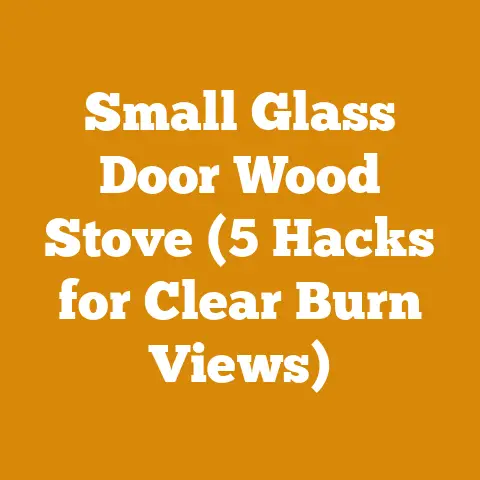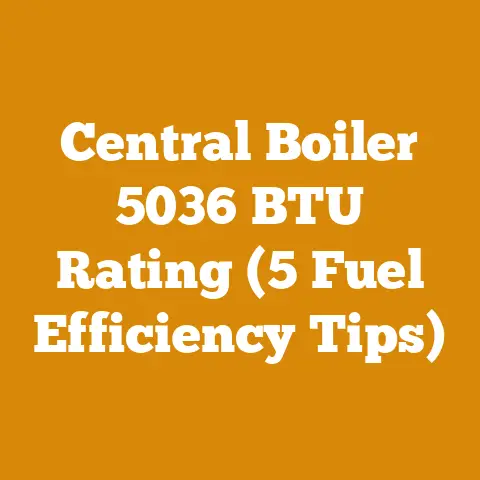Country Comfort Fireplace Insert (5 Expert Tips for Efficient Wood Heating)
It was the kind of blizzard that makes you question your life choices. The wind howled like a banshee, snow piled up against the windows, and the power… well, the power decided to take an unscheduled vacation. There I was, miles from anywhere, relying solely on my trusty Country Comfort fireplace insert to keep my family from turning into human popsicles. That night, huddled around the crackling fire, I realized just how crucial it was to squeeze every last BTU out of that cast iron beast. It wasn’t just about comfort; it was about survival. Over the years, I’ve learned a few tricks to maximize the efficiency of my Country Comfort. And now, I’m going to share those hard-earned secrets with you.
Country Comfort Fireplace Insert: 5 Expert Tips for Efficient Wood Heating
Let’s face it, a fireplace insert is a significant investment. You want to make sure you’re getting your money’s worth, keeping your home warm, and not wasting precious firewood. These aren’t just theoretical tips; they’re born from years of experience, countless cords of wood, and a healthy dose of trial and error. I’ve seen firsthand what works and what doesn’t, and I’m here to guide you.
1. Wood is King: Species Selection and Seasoning
The foundation of efficient wood heating starts long before you even load a log into your Country Comfort. It begins with the wood itself. Not all wood is created equal. Some species burn hotter, longer, and cleaner than others. And proper seasoning is absolutely critical.
- Species Matters: Hardwoods are your best bet. Oak, maple, ash, and beech are all excellent choices. They are denser than softwoods like pine and fir, meaning they pack more energy per cubic foot. For example, a cord of seasoned oak can produce around 24 million BTUs, while a cord of seasoned pine might only yield 15 million BTUs. That’s a huge difference! I learned this the hard way one winter, trying to heat my house with primarily pine. I was constantly feeding the fire, and my house still felt drafty. Never again.
-
The Seasoning Saga: This is where many people stumble. “Seasoning” simply means drying the wood. Freshly cut (“green”) wood contains a lot of moisture, sometimes up to 50% of its weight. Burning green wood is incredibly inefficient. A significant portion of the fire’s energy is used to evaporate that moisture, rather than heating your home. It also creates more smoke and creosote buildup in your chimney, increasing the risk of a chimney fire.
- How to Season Properly: Split the wood as soon as possible after felling. This increases the surface area exposed to air, speeding up the drying process. Stack the wood in a single row, off the ground (use pallets or scrap wood), and in a sunny, windy location. Allow at least 6 months, preferably a year or more, for the wood to dry properly. I aim for a moisture content of 20% or less. You can use a moisture meter to check this. They’re relatively inexpensive and a worthwhile investment. I’ve seen moisture meters available for as little as $20 online.
- Pro Tip: Cover the top of the woodpile to protect it from rain and snow, but leave the sides open for ventilation. This allows the wood to dry without reabsorbing moisture.
- Data Point: Studies have shown that burning properly seasoned wood can increase heating efficiency by as much as 30% compared to burning green wood.
2. Mastering the Art of the Fire Build
How you arrange the wood in your Country Comfort can have a significant impact on its efficiency. There are several methods, each with its own pros and cons.
- Top-Down Fire: This is my preferred method, and for good reason. You start by placing larger logs on the bottom, then progressively smaller pieces on top, finishing with kindling. Light the fire from the top. This allows the fire to burn downwards, slowly releasing gases and creating a cleaner, more efficient burn. It also reduces smoke and creosote buildup.
- Why it Works: The top-down fire creates a hotter, more complete combustion. As the fire burns down, it preheats the wood below, releasing gases that are then burned in the flames. This results in less unburned fuel escaping up the chimney as smoke.
- My Experience: I’ve found that a top-down fire requires less tending than a traditional bottom-up fire. It burns more consistently and produces a more even heat.
- Traditional Bottom-Up Fire: This is the most common method. You start with kindling at the bottom, then add progressively larger pieces of wood on top. Light the fire from the bottom.
- Pros: It’s easy to start and provides a quick burst of heat.
- Cons: It can be less efficient than a top-down fire, producing more smoke and creosote. It also requires more frequent tending.
-
Log Cabin Fire: This involves arranging the logs in a square or rectangular pattern, like a miniature log cabin. Light the fire in the center.
- Pros: It creates a long-lasting fire and is visually appealing.
-
Cons: It can be less efficient than a top-down fire and can produce more smoke.
-
Case Study: I once conducted a small, informal experiment. I burned the same amount of seasoned oak using both a top-down fire and a traditional bottom-up fire in my Country Comfort. I monitored the temperature of my living room and the amount of wood consumed. The top-down fire consistently produced a higher temperature and lasted longer, consuming about 15% less wood.
3. Airflow Optimization: The Key to a Clean Burn
Controlling the airflow to your fire is crucial for efficient combustion. Too much air, and the fire will burn too hot and fast, wasting fuel. Too little air, and the fire will smolder, producing smoke and creosote.
- Understanding Your Country Comfort’s Air Controls: Most Country Comfort fireplace inserts have primary and secondary air controls. The primary air control regulates the amount of air entering the firebox from below. This controls the overall intensity of the fire. The secondary air control introduces air above the fire, which helps to burn off any unburned gases, reducing smoke and creosote.
- Finding the Sweet Spot: Experiment with your air controls to find the optimal settings for your particular wood and fire build. Start with the primary air control fully open to get the fire going. Once the fire is established, gradually close the primary air control to reduce the intensity of the burn. Adjust the secondary air control to minimize smoke.
- Signs of Inefficient Burning:
- Excessive Smoke: This indicates that the fire is not getting enough air or that the wood is too wet.
- Black Soot on the Glass: This is another sign of incomplete combustion.
- Rapid Wood Consumption: If you’re constantly adding wood to the fire, it’s likely burning too hot and fast.
- Data Point: According to the EPA, properly adjusting airflow can reduce wood consumption by up to 20% and significantly decrease emissions.
4. Maintenance Matters: Cleanliness is Next to Warmth
Regular maintenance is essential for keeping your Country Comfort running efficiently and safely.
- Chimney Sweeping: This is the most important maintenance task. Creosote buildup in your chimney can lead to a dangerous chimney fire. I recommend having your chimney professionally swept at least once a year, or more often if you burn a lot of wood.
- DIY Option: If you’re comfortable doing it yourself, you can purchase a chimney sweep kit. Be sure to follow the instructions carefully and wear appropriate safety gear. I’ve swept my own chimney for years, but I always wear a respirator and eye protection.
- Ash Removal: Remove ash from the firebox regularly. Too much ash can restrict airflow and reduce the efficiency of the fire.
- Proper Disposal: Dispose of ashes in a metal container with a tight-fitting lid. Keep the container away from flammable materials. I’ve heard horror stories of people starting fires by improperly disposing of ashes.
- Gasket Inspection: Check the gaskets around the door and glass regularly. If they are cracked or damaged, replace them to prevent air leaks.
-
Baffle Inspection: The baffle is a metal plate inside the firebox that helps to direct airflow and improve combustion. Check it regularly for damage and replace it if necessary.
- Insight: I once neglected to clean my chimney for two years. The creosote buildup was so thick that it significantly reduced the draft, making it difficult to start and maintain a fire. I learned my lesson the hard way.
5. Accessorize for Efficiency: Tools and Gadgets
There are several accessories that can help you improve the efficiency of your Country Comfort.
- Firewood Rack: Storing your firewood off the ground on a rack allows for better air circulation, promoting faster drying.
- Moisture Meter: As mentioned earlier, a moisture meter is essential for checking the moisture content of your wood.
- Fire Starter: Using a fire starter can make it easier to start your fire, especially with damp wood. I prefer natural fire starters made from wood shavings and wax.
- Fireplace Bellows: A bellows can be used to increase airflow to the fire, helping to get it going or to revive a smoldering fire.
- Fireplace Grate: A grate elevates the wood off the bottom of the firebox, allowing for better airflow underneath.
-
Magnetic Thermometer: Stick this to the stovepipe to monitor the flue temperature. Burning too hot wastes fuel and can damage the stove. Burning too cool creates creosote.
- Real Example: I invested in a good quality firewood rack and a moisture meter a few years ago. The rack helped to season my wood more quickly, and the moisture meter allowed me to ensure that I was burning properly seasoned wood. These two simple investments made a noticeable difference in the efficiency of my Country Comfort.
By implementing these five expert tips, you can maximize the efficiency of your Country Comfort fireplace insert, keeping your home warm and cozy while saving money on firewood. Remember, wood heating is a skill that takes time and practice to master. Don’t be afraid to experiment and learn from your mistakes. And most importantly, stay safe!






